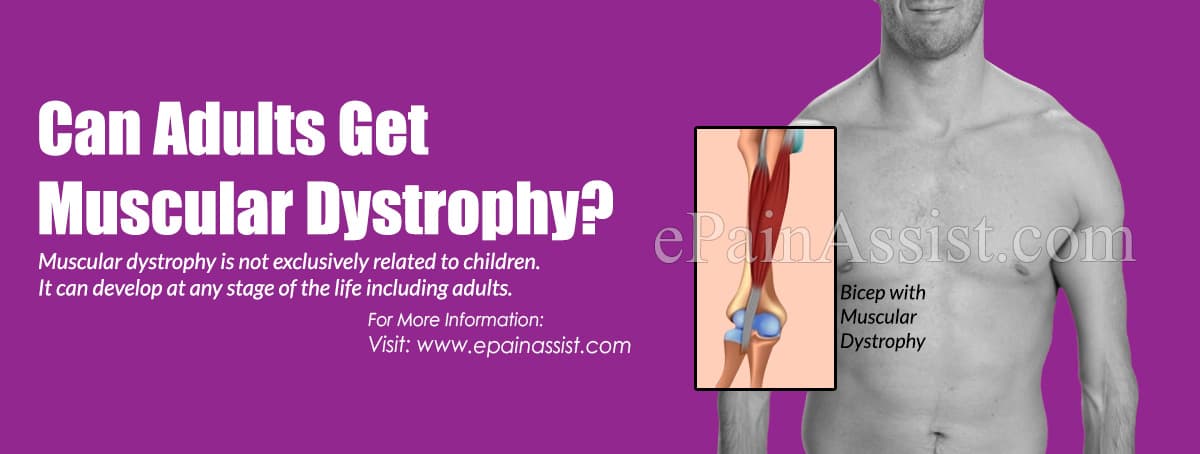Muscular dystrophy is a genetic disease occurring due to gene mutation. This mutation can either be by birth or may develop in later part of life. However, there are various types of muscular dystrophy which are more prevalent in childhood, but the adults also develop muscular dystrophy.1

Can Adults Get Muscular Dystrophy?
Muscular dystrophy is not exclusively related to children. It can develop at any stage of the life including adults. It is a genetic disease and can be either congenital i.e. the disease is present from birth or acquired i.e. it can be contracted later in life. In muscular dystrophy, the gene responsible for the synthesis of dystrophin is mutated leading to the absence of this protein. The symptoms include weak muscles and muscle spasm. This mutation is due to environmental factors and any person at any age if exposed to these factors, the chances of muscular dystrophy is very high.
It has been seen that some types of muscular dystrophy are more prominent in developing in later part of life as compared to other types of muscular dystrophy. Limb-girdle muscular dystrophy occurs later in life and is characterized by weakening of muscles of pelvic and shoulder girdles.2 Ophthalmoplegic muscular dystrophy is another type which shows its symptoms later in life. The condition is characterized by symptoms similar to myasthenia gravis such as drooping eyelids. Further, the ability of the person to swallow is significantly reduced.
Myotonic muscular dystrophy is also commonly found in later part of life. The muscles of neck and face are affected in this muscular dystrophy. Facioscapulohumeral muscular dystrophy occurs in later part of life although it may also develop in childhood.3 Shoulder muscles are primarily affected in this muscular dystrophy.
Diagnosis Of Muscular Dystrophy
Serum Creatinine Kinase Level: Creatine kinase is the enzyme that is present in the muscles. In muscular dystrophy, the muscles are wasted and damaged, thereby increasing the level of this enzyme in the blood. Thus, by testing the presence of this enzyme in high levels in blood, muscle damage can be diagnosed. This is a preliminary test for muscular dystrophy as the level of this enzyme may also increase in inflammation, infections or heavy exercise.
- Electromyography: As the muscles in the patient suffering from muscular dystrophy are weak, muscle MRI is done to analyze the electrical conductivity in the muscle. The electrical activity is measure through electromyography and the weakness in the muscle is noted.
- Muscle Biopsy: Muscle biopsy is the process of removal of apart of the affected muscle and analyzing it in the laboratory. This will give an idea about the problem with the muscle. It also helps in identifying the structural damage to the muscle fibers.
- Muscle MRI: Muscle MRI is used to identify any damaged muscles, or any abnormal muscle especially related to the vital organs such as heart or lungs. Further, the muscle MRI also helps in analyzing the extent of the progression of disease in terms of muscle damage.
- Genetic Testing: Genetic testing is the best method for concluding whether the patient is suffering from muscular dystrophy. Muscular dystrophy is a genetic disease and characterized by the mutation of the gene responsible for the synthesis of dystrophin. Thus, by performing the genetic testing and analyzing that particular gene, the disease can be conclusively diagnosed.
- Chest X-Ray: Chest X-ray is used to analyze the important organs such as lungs and heart. It is done to analyze any abnormal process in these organs such as any cardiac engagement or presence of any fluid in the pleural cavity.
- CT Scan: Muscular dystrophy is the condition in which the muscles are damaged due to absence of a protein called dystrophin. The CT scan is done to identify the presence of any muscle damage, especially in the vital organs.
- Echocardiogram: Functioning of the heart is totally dependent upon the cardiac muscles and any abnormality in cardiac muscles leads to life-threatening complications. Echocardiogram is done to analyze the function of the heart in terms of muscles and valves.
Conclusion
Adults may also suffer from muscular dystrophy. The types of muscular dystrophy found in adults includes limb-girdle muscular dystrophy, ophthalmoplegic muscular dystrophy, myotonic muscular dystrophy and facioscapulohumeral muscular dystrophy.
Also Read:
